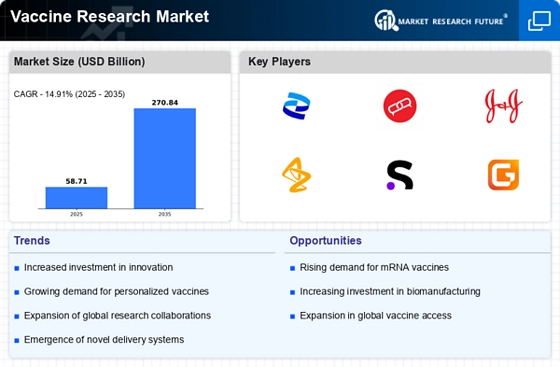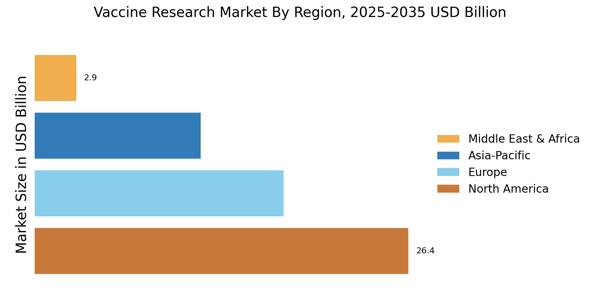Advancements in Biotechnology
Advancements in biotechnology are profoundly influencing the Vaccine Research Market. Innovations such as mRNA technology and viral vector platforms are revolutionizing vaccine development, enabling faster and more efficient production processes. These technologies allow for the rapid design and testing of vaccines, which is crucial in responding to emerging health threats. The market is witnessing a shift towards personalized vaccines, tailored to individual genetic profiles, which could enhance efficacy and safety. As a result, investment in biotechnological research is expected to increase, with projections indicating a potential market growth of 8% annually. This evolution in biotechnology is likely to reshape the landscape of the Vaccine Research Market, fostering a new era of vaccine innovation.
Government Funding and Support
Government funding and support play a pivotal role in the Vaccine Research Market. Various nations are allocating substantial budgets to enhance vaccine research capabilities, recognizing the importance of immunization in public health. For example, recent reports indicate that funding for vaccine research has increased by over 20% in several countries, aimed at bolstering research infrastructure and facilitating clinical trials. This financial backing not only accelerates the development of new vaccines but also encourages collaboration between public and private sectors. As governments continue to prioritize health security, the Vaccine Research Market is likely to benefit from sustained investment, fostering an environment conducive to innovation and growth.
Emerging Markets and Demographic Shifts
Emerging markets and demographic shifts are reshaping the Vaccine Research Market. As populations in developing regions grow and urbanize, the demand for vaccines is expected to rise correspondingly. These areas often face unique health challenges, necessitating tailored vaccine solutions. Furthermore, demographic changes, such as aging populations in developed countries, are likely to increase the prevalence of chronic diseases, further driving the need for vaccines. Analysts estimate that the Vaccine Research Market could see a growth rate of 6% in these emerging markets, as stakeholders adapt to the evolving health landscape. This dynamic environment presents both challenges and opportunities for vaccine researchers and developers.
Rising Incidence of Infectious Diseases
The Vaccine Research Market is experiencing a notable surge due to the increasing incidence of infectious diseases. As pathogens evolve and new strains emerge, the demand for effective vaccines escalates. For instance, the World Health Organization has reported a rise in vaccine-preventable diseases, which necessitates ongoing research and development. This trend is likely to drive investments in vaccine research, as governments and private entities seek to mitigate public health risks. The market is projected to grow at a compound annual growth rate of approximately 7.5% over the next five years, reflecting the urgency to address these health challenges. Consequently, the Vaccine Research Market is positioned to expand significantly as stakeholders prioritize innovative solutions to combat infectious diseases.
Growing Awareness of Preventive Healthcare
The growing awareness of preventive healthcare is significantly impacting the Vaccine Research Market. As populations become more health-conscious, there is an increasing emphasis on vaccination as a primary means of disease prevention. Public health campaigns are effectively educating communities about the benefits of vaccines, leading to higher vaccination rates. This trend is expected to drive demand for new vaccines, particularly in underserved regions where access to immunization is limited. Market analysts project that the focus on preventive healthcare could result in a 10% increase in vaccine research initiatives over the next few years. Consequently, the Vaccine Research Market is likely to expand as stakeholders respond to this heightened awareness.


















Leave a Comment